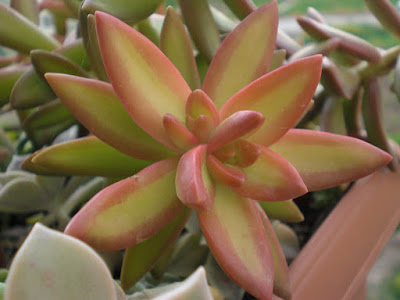Golden Sedum also called as Sedum adolphii, Sedum nussbaumerianum, Coppertone Sedum, is species in the genus Sedum. It is a stunning succulent plant with copper-tone foliage colour when grown in full sun makes this distinctive used in combination plantings.
Golden Sedum also called as Sedum adolphii, Sedum nussbaumerianum, Coppertone Sedum, is species in the genus Sedum. It is a stunning succulent plant with copper-tone foliage colour when grown in full sun makes this distinctive used in combination plantings.
IDENTIFY GOLDEN SEDUM - SEDUM ADOLPHII
Golden Sedum is endemic to the ravines and lava flows of the central part of Veracruz state, in eastern Mexico, where it grows either hanging from rocky cliffs or upright on lava flow. It is abundant in tropical deciduous forest from 400-850 meters above sea level.
Sedum adolphii is a low growing subshrub to 8 inches tall by 2-3 feet wide with decumbent reddish-brown glabrous stems that hold elongating 3 inch wide rosettes of yellow-green to orange thick subterete (half cylindrical) 1 inch long leaves that are pointed at their tips. It is one of the larger-leaved species (about 4 cm long), and turns bright yellow-orange when grown in full sun. In late winter to spring appear the white lightly fragrant flowers in a flat topped umbel-like inflorescence.
GOLDEN SEDUM - SEDUM ADOLPHII CARE AND CULTURE
Cultural information should only be used as a guide, and should be to be adapted to suit you. Your physical location; where you grow your plants, how much time you have to devote to their care, and many other factors, will need to be taken into account. Only then can you decide on the cultural methods that best suit you and your plants.
Light:
Golden Sedum is best grown outdoors. It should ideally get at least six hours of sunlight a day. This succulent’s bright orange color stands out when it is exposed to heat, full sun, and little water. If grown inside, it tends not to thrive and will lose its beautiful copper color.
Before moving the plant outdoors or increasing the amount of sunlight it receives, it is better to acclimate the plant by gradually increasing the amount of sunlight it receives until it is fully acclimated to the more intense sun. Make sure the plants are receiving adequate sunlight throughout the year and are kept in a bright location, even during colder winter months.
Temperature:
Sedum adolphii grow best and can be left outdoors all year long in USDA hardiness zones 9-11.The plant is tolerant to heat but not cold hardy so if you live in a place where temperatures drop lower than 20 °F, it is best to pot the plant indoors. However, it does not grow quite as well indoors due to its high need for sunlight.
For those people in areas with extreme winter conditions, the best way to grow these plants is in containers. That way you can bring them indoors during winter or when there is a forecast of frost or snow. In case you can’t bring your plants in, there are ways to protect them from frost and freezing temperatures outdoors. You can use frost cloths or mini greenhouses to help them survive the cold winter.
To encourage flowering, provide proper temperatures. They need a distinct difference in night and day temperatures as well as summer and winter months. They favor cooler outdoor nighttime temperatures of 50-55 ⁰F (10-13 ⁰C) or indoor night temperatures of at least 60-65 ⁰F(15-18 ⁰C).
Substrate and growing media:
Golden Sedum makes an interestingly colored small-scale ground cover which is nice in xeriscape and rock gardens provided the soil is well draining. It also does well in hanging baskets and draping over walls and in containers; even under planting large succulents in bigger containers.
Although Sedum adolphii can grow in most varieties of soil, it is best to use a porous, well-draining, sandy mixture to avoid diseases that can happen in waterlogged soil.
Watering:
Golden Sedum is drought tolerant but needs occasional irrigation in warm dry climates and during summer months. The top inch of the soil needs to feel dry before you can water again. Test the dryness of the soil before watering to make sure you do not end up overwatering. Too much water and not enough light will cause disaster for these plants.
Fertilizer:
While fertilizing is not necessary, giving your plants the nutrients they need will help ensure proper growth and encourage blooms. It takes a lot of energy for plants to produce flowers, and feeding them extra nutrients will help supplement their needs during the flowering season. The most common recommendation is to fertilize during the active growing season, or during spring and summer months. Fertilizers are better applied at a quarter or half strength, about every two weeks. Refrain from fertilizing towards the end of the fall season and during winter months. A balanced blend of fertilizer diluted to half strength is suitable and commonly used.
Pruning:
Plant can become leggy with age. Easily solved by cutting back stems and replanting them to fill in open areas. You should ideally divide your plant every four years to promote further growth.
Propagation:
Golden Sedum propagates easily due to its fast growth. Propagate by leaves or cuttings. To use cuttings, cut off a stem from the sedum and allow the cut to dry over a few days. Once the cuts dry and callous over, lay it down on a bed of well-drained soil, and wait for roots to form. Water it when the soil gets dry.

















COMMENTS